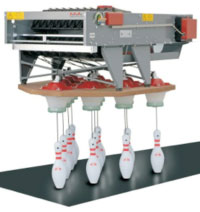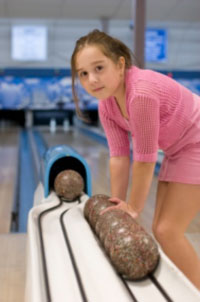Mistagear
www.xgamesbowling.com
Is bowling in the gutter?
 The following article was published in the first issue of the new Interfun Magazine (Issue 1, 2014). The entire issue and the article (on pages 28-31) can be found by clicking here.
The following article was published in the first issue of the new Interfun Magazine (Issue 1, 2014). The entire issue and the article (on pages 28-31) can be found by clicking here.
You can find our CEO Randy White's reply to Roger Creamer at the end of this story. It was not published in Interfun and is being published here for the first time..
Is Bowling in the Gutter? (debate)
No way, says QubicaAMF's Roger Creamer, arguing a mix of family and sports bowling keeps the global industry healthy.
In one corner Randy White, CEO of the White Hutchinson Leisure & Learning Group, an international feasibility, design, production and consulting company specializing in leisure and entertainment venues, argues bowling operators need to embrace a new breed of bowler instead of clinging to old-school sports league standards. In the other corner Roger Creamer, who heads upQubicaAMF's Middle East office and a bowling 'missionary' of considerable fervor, argues bowling isn't in the gutter but that there is room for open play and sports bowling to happily co-exist. White prefixes his points on bowling with the heading: "Paradigm paralysis has bowling in the gutter", a point which Creamer contests with great passion.
Randy White, White Hutchinson
There's a disruption, a nascent revolution, underway in bowling that is starting to undermine the status quo that the old guard continues to defend. Unlike many bowling operators who are prisoners of the past and suffer from paradigm paralysis, new entrepreneurs, many with no history in bowling, are stepping in to offer new types of bowling experiences, which are bringing them success while older bowling alleys are become extinct. As evidence of this extinction, between mid-2008 and mid-2013, the number of commercial bowling centers in the U.S. declined by 14%, yet at the same time the population grew by 4%.
This revolution is being brought about by societal changes. The first and most significant change is that the customer market which leagues were comprised of, predominately an 8-hour shift worker on a regular schedule, is mostly history and along with it the old bread and butter of bowling, the league itself. People no longer are willing to make any type of long-term commitment, let alone for a large number of consecutive weeks. We now live in a time-pressured, spontaneous culture.
Leagues were based on the 'sport' of bowling. So bowling facilities and leagues had to meet USBC (United States Bowling Congress) stringent sanctioned league requirements, including offering ten-pin bowling with all its rules, equipment and maintenance requirements.
Today leagues are a minor market segment of bowling and are on a declining trajectory. Over the last 5 years, the number of USBC certified league bowlers in the U.S. has dropped 30% to 1.7 million, less than 5% of all bowlers. Even if uncertified leagues are included, league bowlers are still less than one-fourteenth (7%) of all bowlers. However, most new entertainment venues that offer bowling, typically with additional entertainment attractions, still build their bowling based on USBC sport bowling standards. Most bowling capital equipment suppliers continue to perpetuate this standard in their offerings, even in emerging economy countries where there is no ten-pin sport bowling tradition. The conventional wisdom of using these design standards is preventing bowling from achieving its full potential.
Another barrier to achieving full potentials is that most new centers, as well as renovated ones, continue to market to both leagues and casual bowlers, attempting to cater to two completely different customer segments. The centers are trying to dip their toes in the future while keeping a foot in the past and as a result end up nowhere near their potentials.
There can be no doubt that the future of bowling is the casual social customer (often referred to in the industry as the open-play bowler) who could care less about USBC standards. In fact, many aren't even concerned about their scores. They just want to have some fun while rolling a ball and socializing with friends or family. And fun for many, especially children and women, is not trying to throw that awkward heavy ten pin bowling ball with the three holes for your fingers. Talk about offering an unfriendly way to have fun.
 And why do we need those monster pinsetters with their multitude of parts that require a full time mechanic to keep them operating? The casual bowler could care less about what spots the pins as long as it works. And those long lanes that take up so much real estate, the casual bowler could care less if they meet USBC length standards. Heck, to keep the casual bowler safe as they often go over the foul line, they could care less if the first foot or so of the lane is even oiled. And speaking about length, the casual bowler could care less about the exact length of the approach.
And why do we need those monster pinsetters with their multitude of parts that require a full time mechanic to keep them operating? The casual bowler could care less about what spots the pins as long as it works. And those long lanes that take up so much real estate, the casual bowler could care less if they meet USBC length standards. Heck, to keep the casual bowler safe as they often go over the foul line, they could care less if the first foot or so of the lane is even oiled. And speaking about length, the casual bowler could care less about the exact length of the approach.
The USBC standards that continue to be followed as bowling's standard are a major obstacle to meeting the potential bowling has to attract casual customers. A few innovative bowling entrepreneurs have seen the light. They are using string pinsetters; they are shortening the lanes and approaches. We are even seeing new centers under development that are looking back into the history of bowling before the USBC (formerly ABC) dominated bowling and are bringing back duckpin bowling, a truly friendly form of bowling for all players that uses a much smaller, much lighter, palmable ball. In fact, 184 older duckpin and candlepin (which also uses a small ball) centers have survived the proliferation of ten-pin bowling in the U.S. due to its user friendliness. Our company has centers under development in both the U.S. and SE Asia that will have duckpin bowling with string pinsetters on shortened lanes and approaches.
There's another societal change that new successful developers understand: today bowling has a lot more competition. With all the very affordable in-home digital entertainment options available that no longer require you to leave home to enjoy great social entertainment options with your family or friends, the bar has been raised for what it takes to attract customers. The new developers also understand that there has been a social stratification of out-of-home entertainment with a market share shift to the higher socioeconomic and aspirational customers. What this means is that you have to offer a luxury experience in an upscale atmosphere to win today. Unfortunately, most existing bowling owners who try to move into the future by renovating their facilities still target the fast shrinking middle socioeconomic market with non-luxury remodels and so-so food, missing their greatest market opportunity.
The new entrepreneurs don't even consider themselves in the bowling business. They see bowling only as a part of a larger synergistic socialization mix that includes an upscale atmosphere, contemporary food and beverage offerings, great hospitality and service, and often, other forms of entertainment. For them, bowling revenue is no longer in the majority.
To find success, more bowling centers need to free themselves from USBC-design-and-operations-paralysis and design and operate to attract contemporary casual customers.

You can find our CEO Randy White's reply to Roger Creamer at the end of this story. It was not published in Interfun and is being published here for the first time..
Is Bowling in the Gutter? (debate)
No way, says QubicaAMF's Roger Creamer, arguing a mix of family and sports bowling keeps the global industry healthy.
In one corner Randy White, CEO of the White Hutchinson Leisure & Learning Group, an international feasibility, design, production and consulting company specializing in leisure and entertainment venues, argues bowling operators need to embrace a new breed of bowler instead of clinging to old-school sports league standards. In the other corner Roger Creamer, who heads upQubicaAMF's Middle East office and a bowling 'missionary' of considerable fervor, argues bowling isn't in the gutter but that there is room for open play and sports bowling to happily co-exist. White prefixes his points on bowling with the heading: "Paradigm paralysis has bowling in the gutter", a point which Creamer contests with great passion.
Randy White, White Hutchinson
There's a disruption, a nascent revolution, underway in bowling that is starting to undermine the status quo that the old guard continues to defend. Unlike many bowling operators who are prisoners of the past and suffer from paradigm paralysis, new entrepreneurs, many with no history in bowling, are stepping in to offer new types of bowling experiences, which are bringing them success while older bowling alleys are become extinct. As evidence of this extinction, between mid-2008 and mid-2013, the number of commercial bowling centers in the U.S. declined by 14%, yet at the same time the population grew by 4%.
This revolution is being brought about by societal changes. The first and most significant change is that the customer market which leagues were comprised of, predominately an 8-hour shift worker on a regular schedule, is mostly history and along with it the old bread and butter of bowling, the league itself. People no longer are willing to make any type of long-term commitment, let alone for a large number of consecutive weeks. We now live in a time-pressured, spontaneous culture.
Leagues were based on the 'sport' of bowling. So bowling facilities and leagues had to meet USBC (United States Bowling Congress) stringent sanctioned league requirements, including offering ten-pin bowling with all its rules, equipment and maintenance requirements.
Today leagues are a minor market segment of bowling and are on a declining trajectory. Over the last 5 years, the number of USBC certified league bowlers in the U.S. has dropped 30% to 1.7 million, less than 5% of all bowlers. Even if uncertified leagues are included, league bowlers are still less than one-fourteenth (7%) of all bowlers. However, most new entertainment venues that offer bowling, typically with additional entertainment attractions, still build their bowling based on USBC sport bowling standards. Most bowling capital equipment suppliers continue to perpetuate this standard in their offerings, even in emerging economy countries where there is no ten-pin sport bowling tradition. The conventional wisdom of using these design standards is preventing bowling from achieving its full potential.
Another barrier to achieving full potentials is that most new centers, as well as renovated ones, continue to market to both leagues and casual bowlers, attempting to cater to two completely different customer segments. The centers are trying to dip their toes in the future while keeping a foot in the past and as a result end up nowhere near their potentials.
There can be no doubt that the future of bowling is the casual social customer (often referred to in the industry as the open-play bowler) who could care less about USBC standards. In fact, many aren't even concerned about their scores. They just want to have some fun while rolling a ball and socializing with friends or family. And fun for many, especially children and women, is not trying to throw that awkward heavy ten pin bowling ball with the three holes for your fingers. Talk about offering an unfriendly way to have fun.

The USBC standards that continue to be followed as bowling's standard are a major obstacle to meeting the potential bowling has to attract casual customers. A few innovative bowling entrepreneurs have seen the light. They are using string pinsetters; they are shortening the lanes and approaches. We are even seeing new centers under development that are looking back into the history of bowling before the USBC (formerly ABC) dominated bowling and are bringing back duckpin bowling, a truly friendly form of bowling for all players that uses a much smaller, much lighter, palmable ball. In fact, 184 older duckpin and candlepin (which also uses a small ball) centers have survived the proliferation of ten-pin bowling in the U.S. due to its user friendliness. Our company has centers under development in both the U.S. and SE Asia that will have duckpin bowling with string pinsetters on shortened lanes and approaches.
There's another societal change that new successful developers understand: today bowling has a lot more competition. With all the very affordable in-home digital entertainment options available that no longer require you to leave home to enjoy great social entertainment options with your family or friends, the bar has been raised for what it takes to attract customers. The new developers also understand that there has been a social stratification of out-of-home entertainment with a market share shift to the higher socioeconomic and aspirational customers. What this means is that you have to offer a luxury experience in an upscale atmosphere to win today. Unfortunately, most existing bowling owners who try to move into the future by renovating their facilities still target the fast shrinking middle socioeconomic market with non-luxury remodels and so-so food, missing their greatest market opportunity.
The new entrepreneurs don't even consider themselves in the bowling business. They see bowling only as a part of a larger synergistic socialization mix that includes an upscale atmosphere, contemporary food and beverage offerings, great hospitality and service, and often, other forms of entertainment. For them, bowling revenue is no longer in the majority.
To find success, more bowling centers need to free themselves from USBC-design-and-operations-paralysis and design and operate to attract contemporary casual customers.


